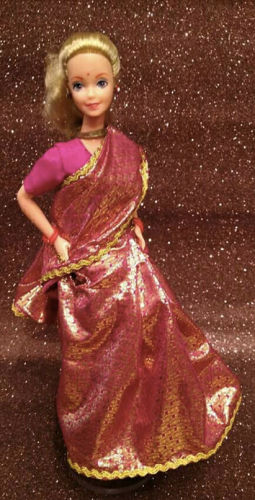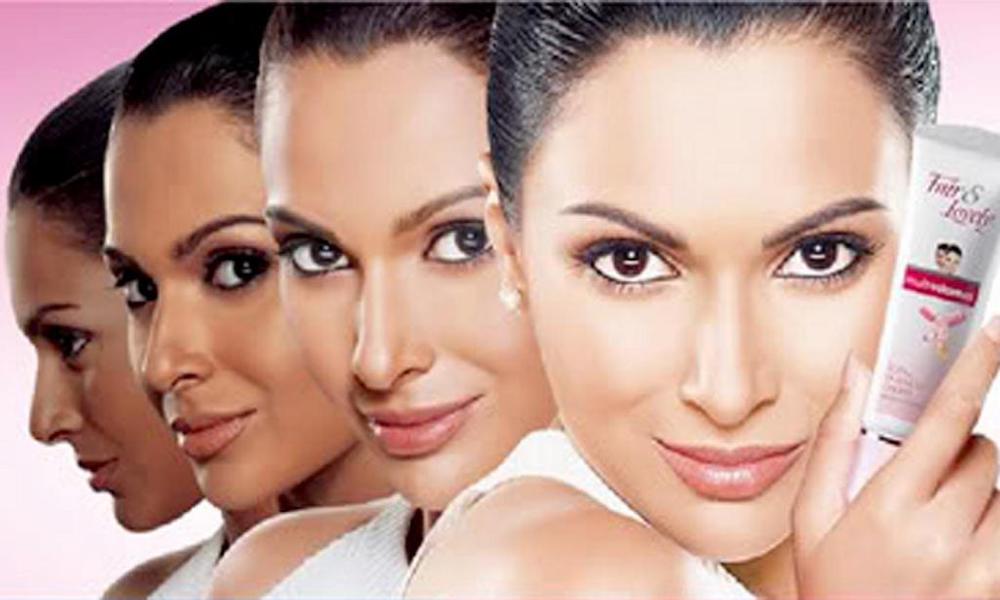by Akhila Kolisetty – Follow @akhilak

As a young child growing up in New Jersey, I remember playing with one of my favorite dolls, an “Indian” Barbie. The Barbie wore a shiny red sari and blouse, and was adorned with dangling gold earrings, a gold necklace, and a glittering ring on her finger. I played happily with my Barbie, brushing her hair and tying her sari, without noticing anything unusual about the doll. Blissful in my innocence, the Barbie epitomized beauty in my youthful eyes.
 Only years later when I pulled out my childhood toys from storage did I realize something that I simply could not shake from that moment forward: this doll was “white”: a typical slim, pale, blond-haired Barbie-like any other. There was nothing “Indian” about the doll’s skin tone. She had never been “Indian Barbie,” though I had taken her as such. She was just “Barbie in India.”
Only years later when I pulled out my childhood toys from storage did I realize something that I simply could not shake from that moment forward: this doll was “white”: a typical slim, pale, blond-haired Barbie-like any other. There was nothing “Indian” about the doll’s skin tone. She had never been “Indian Barbie,” though I had taken her as such. She was just “Barbie in India.”
“How could it be that this doll was passed off as “Indian” for so long?” I wondered.
All those years, my ideal of beauty was a beautiful blonde with light skin, not a doll who looked anything remotely like me: brown skinned, dark-eyed, thick black hair, bushy eyebrows. As a South Indian, I was also darker than most of those Bollywood heroines I’d watched in countless films. They formed the standard of beauty: you had to be as close to white as possible while still being brown.
My colorism complex only worsened by innocuous comments by relatives, who also gave me gifts of “Fair and Lovely” creams and lotions that promised to lighten my skin. I’d hear whispers at weddings:
“Why is he marrying such a dark skinned girl? Couldn’t he have found someone better looking?” “Please, help me find a fair woman for my son,” the aunties would request. “Do you know anyone?”
No wonder that while growing up, I dreaded spending time outside in the summer, and especially avoided going into a swimming pool. The combination of the heat, water and chlorine would inevitably cause my skin to darken by three shades over the course of a summer afternoon. Traveling to India in the summer was the worst – I knew I’d come back home darker than I ever wanted to be. I’d look forward to the winters when I was at my palest, which I equated to being my loveliest.
As I reached my mid-twenties, I thought I’d grown into my skin and rarely considered my skin color when I looked in the mirror. But recently, I went to a pharmacy to try on different shades of foundation. I looked for my favorite, Revlon Colorstay, but when I asked for advice on which shade was ideal for my skin tone, I was surprised by the answer. The makeup artist at the store told me that I’d been applying the wrong shade all along. Taking a quick look at my skin, she told me that I was a shade darker: caramel, not natural tan. Nevertheless, I insisted that the shade was too dark for me.
“No,” she said. “This one will be much better on your skin.”
To my surprise, it turned out that she was right. The suggested shade had warmer undertones to it and made my skin glow. The paler shades I had been using were washing me out, doing my skin no favors. I grew to love this new shade, and my new understanding of my skin. But this experience showed me how deeply ingrained those colorist beliefs had become for me, so deep as to have seeped into my subconscious, even guiding my decisions on picking appropriate makeup. At some level, I had clearly wanted to be lighter than I was, though I hadn’t realized it.
Nothing in this story is at all unique, of course. It is no secret that in our communities – and in fact, across many communities of color – there is a certain kind of self-hatred based on skin color. We refuse to marry the white man, but at some level, we want to be him. Much of this can be traced back to the legacy of colonialism, when the British often favored those Indian castes and peoples with lighter skin while discriminating against “black-skinned” Indians. Light skin also indicated that a person was able to stay in the home and didn’t need to labor outside beneath the hot sun to make a living. This desire for whiteness also comes with a hefty dose of anti-blackness in our community in America, with stereotypes and prejudices against African-Americans that serve to somehow elevate the South Asian-American community’s sense of self as immigrants.
[Read Related: Why Confronting Anti-Black Racism as South Asians of the Next Generation is so Important]
My generation, the children of the 1990s and early 2000s, didn’t have public role models in media, entertainment and politics who looked like us. There was no Nina Davuluri, a South Indian whose skin tone mirrored mine, who won an American beauty pageant. As a teenager, I never got to see Mindy Kaling write, produce and act in her own TV show. I didn’t have a Rupi Kaur to tell me that being a brown girl was beautiful. I never saw an assertive brown woman like Kamala Harris interrogate our Attorney General with poise, passion and strength. And I most definitely never saw a “Muslim” Barbie with a hijab or an actual “Indian” Barbie with warm caramel skin and thick black hair.
Despite this, there is hope to be had for the next generation. Today’s young brown girls, and my future children, will, I hope, have women who look like them in high places as the media’s portrayal of beauty and strength is remodeled and expanded. They will know that their skin, too, is lovely – that they are just perfect, and powerful, the way they are made, thick black hair, melanin and all. And that will make all the difference.

 Akhila is a lawyer and advocate residing in New York, an Indian-American immigrant and a feminist. She provides legal representation and advice to survivors of domestic violence, and is passionate about combating gender-based violence and discrimination through law, policy and writing.
Akhila is a lawyer and advocate residing in New York, an Indian-American immigrant and a feminist. She provides legal representation and advice to survivors of domestic violence, and is passionate about combating gender-based violence and discrimination through law, policy and writing.



